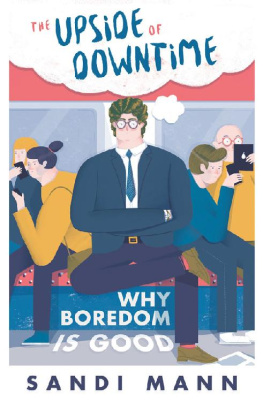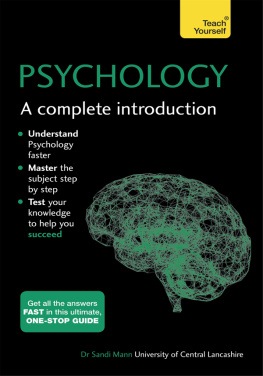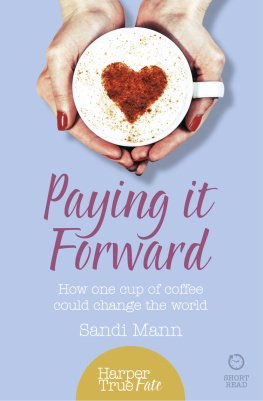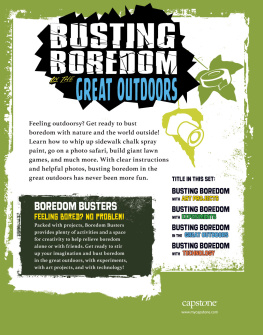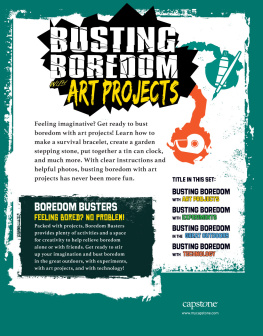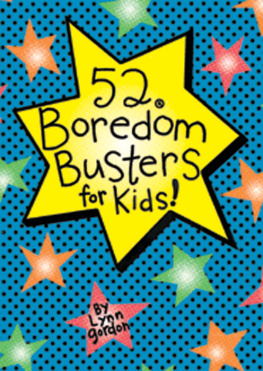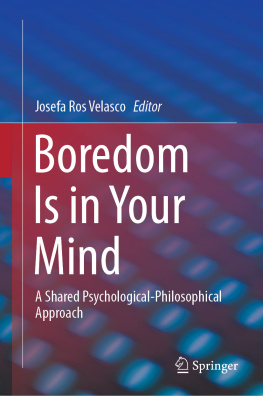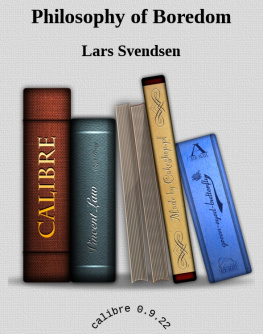Sandi Mann - The Science of Boredom: Why Boredom Is Good
Here you can read online Sandi Mann - The Science of Boredom: Why Boredom Is Good full text of the book (entire story) in english for free. Download pdf and epub, get meaning, cover and reviews about this ebook. year: 2016, publisher: Hachette UK, genre: Religion. Description of the work, (preface) as well as reviews are available. Best literature library LitArk.com created for fans of good reading and offers a wide selection of genres:
Romance novel
Science fiction
Adventure
Detective
Science
History
Home and family
Prose
Art
Politics
Computer
Non-fiction
Religion
Business
Children
Humor
Choose a favorite category and find really read worthwhile books. Enjoy immersion in the world of imagination, feel the emotions of the characters or learn something new for yourself, make an fascinating discovery.
- Book:The Science of Boredom: Why Boredom Is Good
- Author:
- Publisher:Hachette UK
- Genre:
- Year:2016
- Rating:3 / 5
- Favourites:Add to favourites
- Your mark:
- 60
- 1
- 2
- 3
- 4
- 5
The Science of Boredom: Why Boredom Is Good: summary, description and annotation
We offer to read an annotation, description, summary or preface (depends on what the author of the book "The Science of Boredom: Why Boredom Is Good" wrote himself). If you haven't found the necessary information about the book — write in the comments, we will try to find it.
Sandi Mann: author's other books
Who wrote The Science of Boredom: Why Boredom Is Good? Find out the surname, the name of the author of the book and a list of all author's works by series.
The Science of Boredom: Why Boredom Is Good — read online for free the complete book (whole text) full work
Below is the text of the book, divided by pages. System saving the place of the last page read, allows you to conveniently read the book "The Science of Boredom: Why Boredom Is Good" online for free, without having to search again every time where you left off. Put a bookmark, and you can go to the page where you finished reading at any time.
Font size:
Interval:
Bookmark:


ROBINSON
First published in Great Britain in 2016 by Robinson
Copyright Sandi Mann, 2016
The moral right of the author has been asserted.
All rights reserved.
No part of this publication may be reproduced, stored in a retrieval system, or transmitted, in any form, or by any means, without the prior permission in writing of the publisher, nor be otherwise circulated in any form of binding or cover other than that in which it is published and without a similar condition including this condition being imposed on the subsequent purchaser.
A CIP catalogue record for this book
is available from the British Library.
ISBN 978-1-47213-600-8
Robinson
is an imprint of
Little, Brown Book Group
Carmelite House
50 Victoria Embankment
London EC4Y 0DZ
An Hachette UK Company
www.hachette.co.uk
www.littlebrown.co.uk
Dedicated to Dania, Elisha and Akiva,
who ensure that my life is never boring!
Thanks to everyone who has taken part in my boredom research over the years I hope it was not too boring. Thanks too to my lovely agent, Chelsey Fox, who has put up with my obsession with boredom for many years now without ever indicating that she was bored of it!
Contents
My first ever graduate job was as a shop assistant in a very quiet high-street clothes shop, where I was so bored that I resorted to unfolding sweaters and refolding them, just to have something to do (unsurprisingly, the store has since closed down). So began a lifelong interest in boredom that was not quashed by my next job, which was only marginally less tedious; as a cytology screener, my job was to sit gazing down a microscope at cells all day in order to spot the occasional unhealthy one. I remember finding this vigilance task so dull that I begged to be permitted to listen to music via my headphones in order to provide some much-needed stimulation. This request was refused on the grounds that the music might be distracting; and so my mission to explore boredom and to research ways of coping with it was born. My subsequent years of research into boredom have taught me (amongst other things) what I instinctively knew then that far from being a distraction, extra stimulation like music can help people cope with tedious, repetitive tasks. I would love to be able to go back to my ex-employer and show them my findings, but that job too has now gone, to be replaced by computers (who never get bored!).
This book then is the result of years of research that, unlike my first two jobs, has never been dull. It is for everyone who is ever bored and for those who go to great lengths to ensure they never are. In a world in which many of us seek ever more stimulation in an attempt to counter our lowering threshold for boredom, The Upside of Downtime is about not just helping us cope with boredom, but also about harnessing its power. For the reality is that, despite the ever-increasing ways in which to entertain ourselves today, we appear to be more bored at school, at work and at play than ever before. Internet, DVDs, iPhones, Xboxes, PlayStations, 24-hour supermarkets, multiple TV channels, cinemas, bowling, retail parks, online chatrooms, Facebook, Twitter, MSN, texting... today we have so many varied ways to spend our leisure time that we should all surely never know what boredom feels like. Yet boredom appears to be the curse of the twenty-first century; it seems that the more we have to stimulate us, the more stimulation we crave. The fast pace of the world means that in an environment characterised by change, speed and novelty, we are losing the ability to tolerate the routine and repetition of everyday life. We experience this lack of tolerance as the uncomfortable feeling of boredom, and it is the motivation to reduce this ennui that leads us in a never-ending quest for stimulation.
This quest brings a whole plethora of consequences: kids hang out on street corners causing trouble because they are bored; people of all ages become addicted to drugs or gambling or pornography because they are constantly seeking more stimulation; others take risks or seek ever-more dangerous thrills (hence the growth in extreme sports) in order to relieve the tedium of their lives; still more over-indulge in shopping or eating in order to bring much-needed stimulation into their lives.
How has this happened? And, how can we stop it? The Upside of Downtime examines the evidence and looks at the causes and consequences of boredom in the twenty-first century. This book will start with an exploration of the concept of boredom, debunking a few myths along the way (for example, that boredom is the result of having nothing to do). The central premise of the book, that boredom is actually beneficial for us, is suggested from the outset, with this idea being developed as the book progresses. Using my own groundbreaking research into boredom, as well as that of other international researchers, the text tells the story of what we do when we are bored; how we act, react and how we cope.
The causes of boredom are explored in detail, with the relative roles of environment, personality and other people being debated; are we bored because life now is too routine and repetitive? Or is it just that we are more boredom-prone? Or are we bored because other people are boring us (and, heaven help us, could we be that boring person?)?
Boredom within the education system is discussed with an expos of how schools are creating a boredom-prone society with their increasing emphasis on whizzy teaching involving ever-more interactive whiteboard technology. It will be argued that we are growing a nation of children who expect to be entertained to such an extent that they are unable to cope with lower levels of stimulation. Combined with all the instant and engaging (but soundbite-short) technology around them, our kids are growing up with ever-decreasing attention spans and thresholds for boredom. They are getting bored more easily and lack the skills to cure their ennui themselves. And yet, just when peoples boredom thresholds are being lowered, and they need higher levels of stimulation to satisfy their quest for engagement, they find themselves entering a world of work that is increasingly boring (due to increased bureaucracy, paperwork, legislation and routinisation).
The consequences for society of all this boredom are worrying. Much of societys ills can be laid at the door of boredom, either because of our reactions to being bored (e.g. risk-taking, thrill-seeking, vandalism, drug-taking, etc.) or because of the effects that being bored have on our minds and bodies. Indeed, this book will go on to argue that boredom is the new stress, and just as harmful.
The Upside of Downtime , however, ends on a positive note. Despite the gloom and doom of boredom, it has its upsides too. The antidote to boredom is humour and fun, both of which can be used to enrich society. Boredom also carries with it many useful functions, including being the catalyst for creativity, and my new research demonstrating this link is described here. The book offers the somewhat radical view that the solution to the boredom problem is to harness boredom rather than trying to avoid it. As a society, we think we have failed if we are bored, but this book will argue that boredom can be a powerful, motivating force that instils creativity, intelligent thinking and reflection if only we allow it back into our lives. Some people are already catching on to this, with signs that there is a movement away from wanting constant stimuli in our lives towards a desire for the real freedom that gadget- and connection-free time (e.g. on holiday) can provide. British journalist and broadcaster Mariella Frostrups recent comments in The Times about her downtime holiday illustrate this trend: left to idle away a week with little phone signal and no technology was the greatest luxury we could hope for. She is not alone in seeking time out from the demands of a 24/7 society as we are starting to tip more positively towards boredom. The Upside of Downtime aims to lead the way.
Next pageFont size:
Interval:
Bookmark:
Similar books «The Science of Boredom: Why Boredom Is Good»
Look at similar books to The Science of Boredom: Why Boredom Is Good. We have selected literature similar in name and meaning in the hope of providing readers with more options to find new, interesting, not yet read works.
Discussion, reviews of the book The Science of Boredom: Why Boredom Is Good and just readers' own opinions. Leave your comments, write what you think about the work, its meaning or the main characters. Specify what exactly you liked and what you didn't like, and why you think so.

